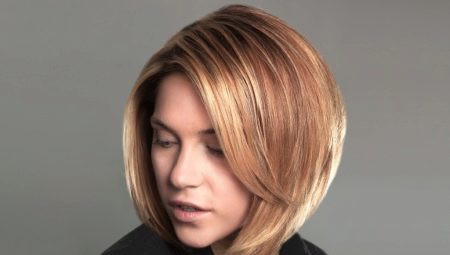Today, it is impossible to surprise anyone with the usual classic highlighting on the hair. It has become so popular that it is possible to make it in absolutely any salon and even with masters at home. Those girls who prefer to be at the peak of fashion make more complex coloring. California or French highlights, shatushu or ombre - all these are the types of lightening and coloring of individual parts of the hair.
However, highlighting them is highlighting in the technique of "veil", covering the hair, like a cape of the finest threads.
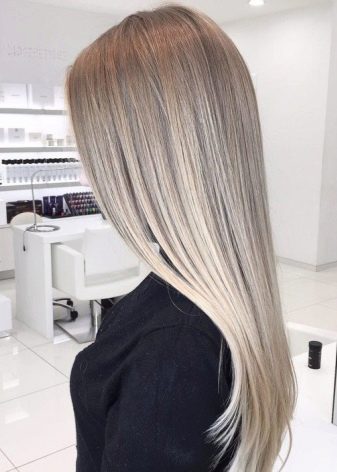

Features
Veiling - in essence, represents the same lightening of individual strands as conventional highlighting, but performed by a special method. In order to create the effect of thin lace or even cobwebs, choose strands with a thickness of not more than 2-3 mm. Such thin curls should literally shine through in the palm of your hand. Lighten them along the entire length, but only the outer surface of the hair is stained.
You can choose different strands for lightening. Most often, veil staining is carried out by darning. In this case, a wide (2-3 cm) strip of hair is first separated, and it is already divided into small strips. Stain such strips through one, as if stitches with a needle or darn. In some cases, dye every third strand, or separate the necessary parts of the hair, conducting zigzag partings with the thin end of a special comb.
The clarification itself occurs with a closed type using strips of foil.

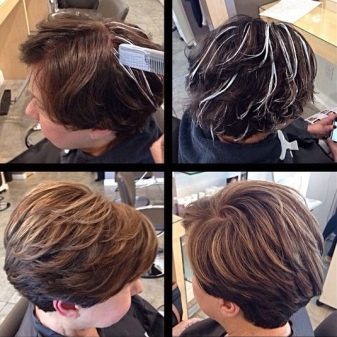
One of the most popular execution techniques is a procedure called Ice Tint. In this case, they obtain strands of the shade of a cold blond, which creates the impression of the ends of the hair burned out in the sun. In order to make the color transition smoother, the master can use a stretch of 3-5 colors.
Such dyeing is suitable only for owners of fair hair and skin, but it looks very unusual and, despite the bright white color, more natural than ordinary highlighting with wide strands.
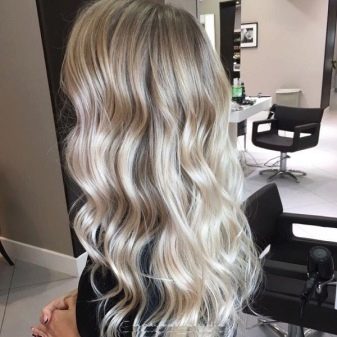
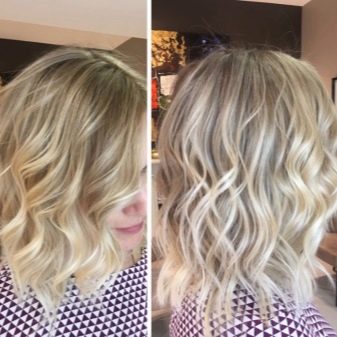
Advantages and disadvantages
Like any other hair dyeing technique, veiling has its pros and cons. Among the advantages of this type of lightening strands, several factors can be distinguished.
- Looks great on any hair. Processing of such thin strands allows you to create the effect of natural volume and splendor of even the thinnest and lifeless hair. At the same time, a suitable shade and frequency of clarified strands can be selected for almost any length and type of hair.
- Does not change hair color completely. When highlighting using the “veil” technique, the brunette will still remain brunette, and the redhead will remain red. Thin clarified strands do not change the color of the hair, but only favorably shade it and give a certain sophistication.
- Gentle method. Since dyeing is carried out on a very small part of the hair and only on their external side, this method can be called quite gentle. Unlike conventional dyeing, veiling retains about 80-90% of hair.
- Masks gray hair. In the event that a woman does not want to have gray hair, but is not ready to spoil their health with full dyeing, veiling is perfect for masking individual gray strands. If you make a long stretch of color using several shades of paint, you can get an interesting overflow effect.
- Correction is carried out less often, and the growing roots are almost not visible. Veiling allows you to be more relaxed about staining due to the fact that the roots of the colored strands are thinner. In the event that the desire to renew highlighting does not arise, the strands can be easily grown without resorting to full coloring or lightening of the hair.
- Helps to correct facial imperfections. Properly selected color and width of highlighted strands can obscure too round cheeks or, conversely, emphasize high cheekbones.
The main thing is to choose a good master who knows how to adhere to the staining technology itself and who knows how to best present certain client features.
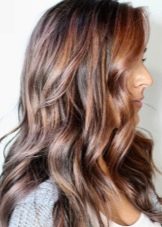

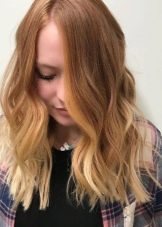
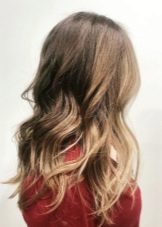
Unfortunately, many drawbacks of this technique can also be identified.
- The duration of the procedure. Separating the thinnest strands, dyeing them individually and packing in foil is an occupation that requires 3 to 6 hours. The duration, of course, depends on the density and length of the hairstyle, but even a short bean or square will require at least 2.5-3 hours from the master.
- The complexity of the procedure. Not every trained professional knows how to lighten hair using the veil technique. Not to mention the masters of self-taught. Experts strongly recommend abandoning attempts to veil independently even short hair at home. The result can be quite sad and require drastic lightening or hair dyeing to get rid of the consequences.
- The high cost of the procedure. Based on the duration and complexity of such highlighting, there is a rather high price for such a service. Along with other popular dyes, it is veiling that is considered the most painstaking operation with hair. However, it is not recommended to save on such services, since a performance error will negate the entire effect of the veil.
- Dries and spoils hair. Even such a gentle procedure is lightening, which spoils the hair, makes individual strands more brittle and dull. In this case, a closed method in which foil is used is considered more harmful.
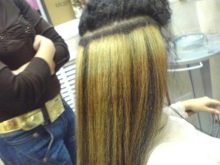
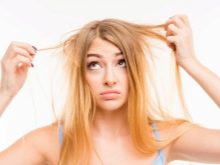
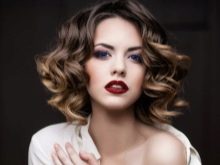
Thus, each woman herself chooses whether the advantages of the technique of veiling hair outweigh her cons.According to online surveys, the majority prefers highlighting with thin stripes because in this case the hairstyle looks longer fresh and voluminous even without adjustment. And the adjustment itself can be done much less often, once every 2-3 months, depending on the speed of hair growth.
How to choose a shade?
Despite the fact that veiling is perfect for almost any hair and color types, the ideal option is quite difficult to choose. The exact shade is very individual and depends both on the length or basic color of the hair, and on their type, face shape and facial features.
In order not to spoil the hair, sorting through many shades and the width of the clarified strands, it is enough to contact a professional salon. The specialist will give a recommendation based on certain rules.
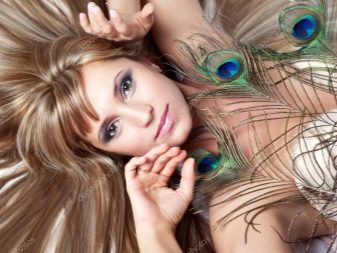
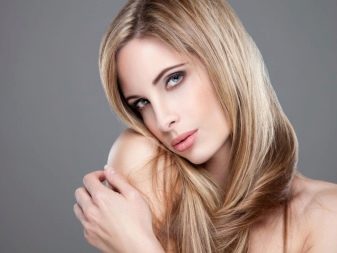
Length and color of hair
Owners of blond hair with a warm shade should choose beige and honey tones. A shade of light wheat or champagne will allow you to achieve the effect of strands burnt in the sun and make facial features softer and calmer. For those whose natural hair and skin have a cool shade, the Ice Tint technique is perfect. The strands are painted in ash, pearl and pearl. The noble ivory color is emphasized by the depth of the eyes and the line of the chin.
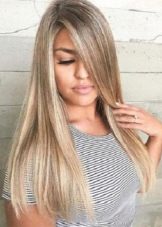


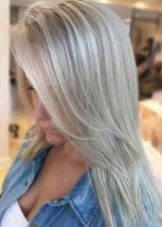
On dark hair, contrasting strands of saturated color will look great. The best choice will be a noble honey, cognac or caramel shade. Red-haired beauties fit a shade of copper and gold.
The strands on dark hair should be slightly wider, dyeing is best done using several colors to make the transition softer and more natural.

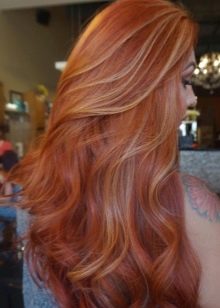
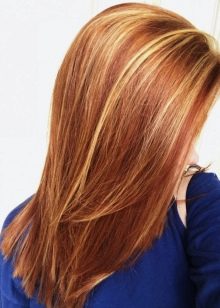
The fair-haired beauties should opt for a light blond shade, honey or nut. Veiling suggests naturalness. And this means that the shade of paint should be selected pretty close to natural. So, burning brunettes should not make a veil with strands of pearl color, and natural blond will be lost against a bright caramel.
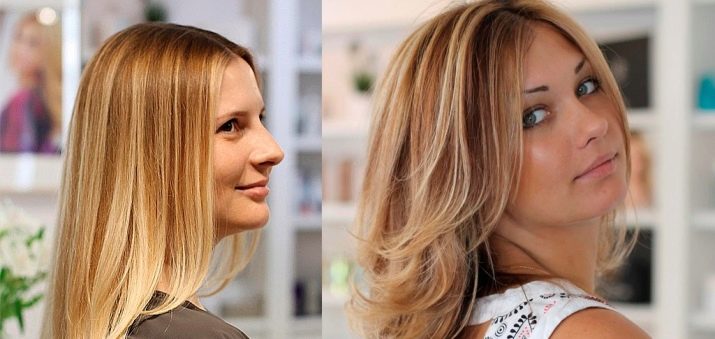
The length of the hair does not affect the color of the paint, but rather strongly affects the thickness and number of colored strands. In this case, the rule works: the shorter the haircut, the more frequent and thin strands are taken for dyeing. A thin web of 1-2 tones lighter than natural hair will beautifully shimmer in the sun in a short haircut. And wide smooth transitions are more suitable for owners of thick and long curls. On straight hair, more frequent and thinner strands look better, but on wavy and curly hairs - vice versa.
Moreover, the greater the density and length of the hair, the more difficult it is to make veil highlighting so that the result retains contrast, but does not look rough.
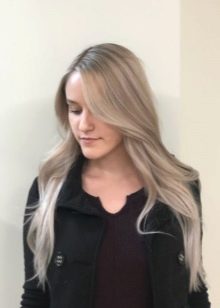
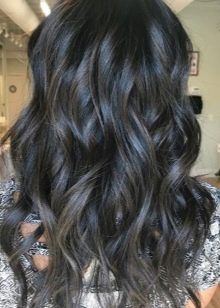
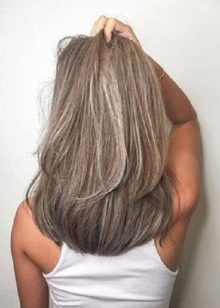
By face type
Depending on what geometric shape the client’s face resembles, the master selects the highlighting method and its features.
Oval
This type is considered the reference, any haircuts, styling and coloring are suitable for it. However, it can also be favorably emphasized by the right choice of color. Golden shades will make the skin look healthier and younger, while silver shades will mask the redness and irritation on the skin.
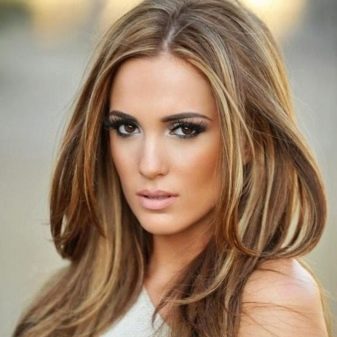
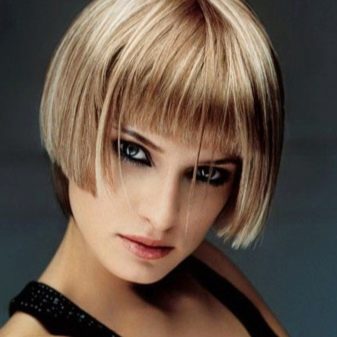
Rectangle
The main drawback of such a person is considered to be an overly massive chin. In order to soften its line and emphasize the cheekbones, it is worth highlighting the upper parts of the strands with a lighter shade, and the lower ones with a darker shade. The same technique is suitable for a square type of face.
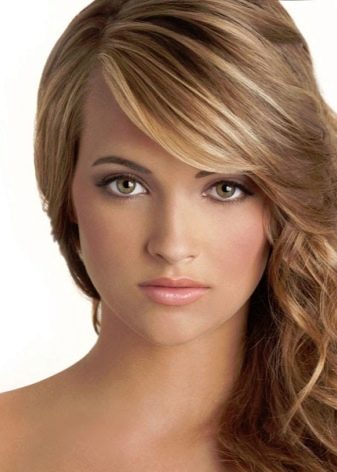
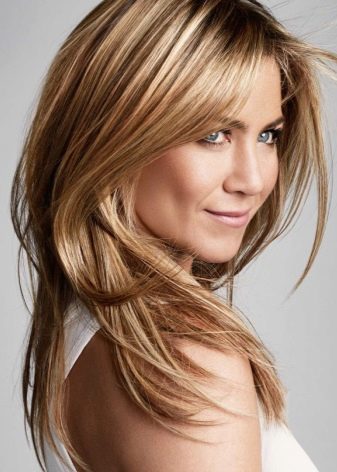
Triangle
In this case, a lighter shade on the chin and a less lighter shade on the forehead can be slightly balanced and the face shape aligned. In the event that the face resembles not a triangle, but a rhombus, the strands should be lighter both on the forehead and on the chin, and in the middle should have a darker shade.

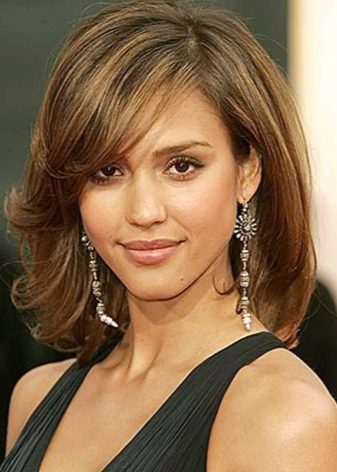
A circle
A round face is perhaps the only type to which highlighting is not very suitable, no matter what technique is chosen.Owners of this type should pay their attention to the coloring of individual strands, on the contrary, in darker shades.
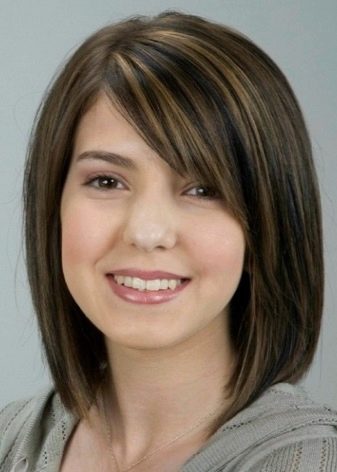
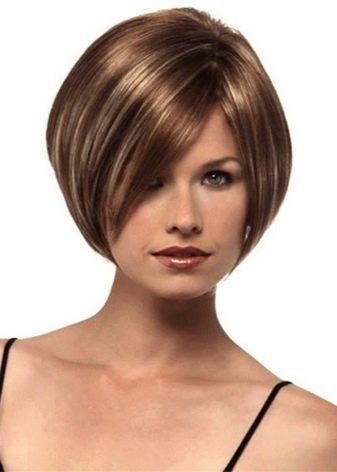
How to care?
Lightening hair makes it brittle and dry. In order to restore their health and shine, it is necessary to use special means purchased in a pharmacy and store or made independently. It can be various masks, gels, serums and vibes. At home, you can cook a variety of decoctions, which rinse your hair during washing. In addition, after staining, it is very useful to massage the head.
This procedure does not require special knowledge and skills, it can be carried out independently in just 10-15 minutes a day.
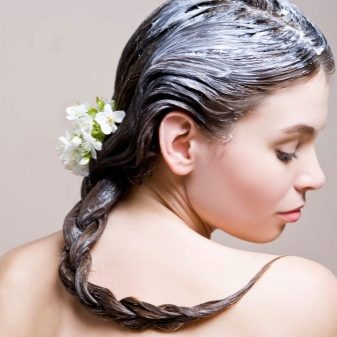
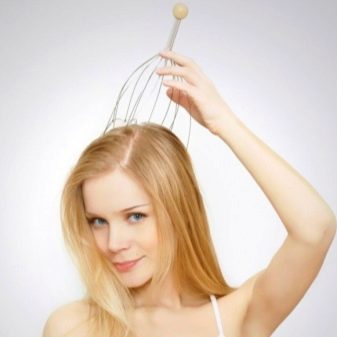
In winter and autumn, during rain and frost, hair is best removed under a hat, scarf or hood. The comb for daily styling should be made of natural materials and have wide teeth that do not injure hair and scalp. Do not abuse the use of irons, curlers and tricks, as they greatly damage the hair during heating.
And most importantly, do not forget that the most useful for health, density of hair and their shine is a healthy diet, walks in the fresh air and a good night's sleep.
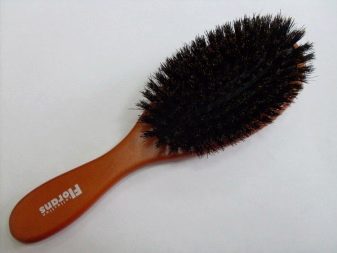
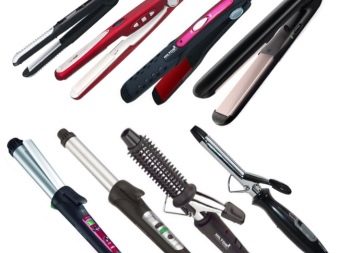

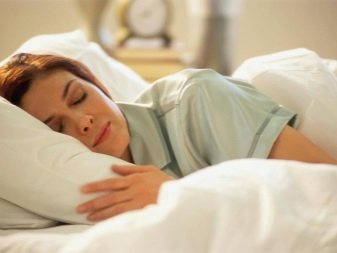
Beautiful examples
The intensity and hue of lightening can be varied to your liking. Both contrasting transitions and a soft, barely perceptible veil on blond hair look great.
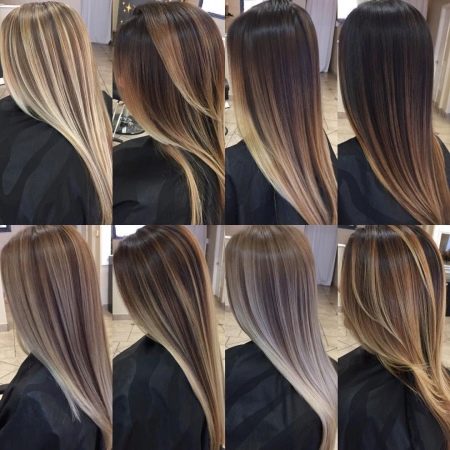
In addition to the intensity of staining, you can choose the length of clarification, and its beginning.
It is not necessary to start staining strands from the very roots. The effect of a slightly overgrown hairstyle will add an image of freedom and relaxation.
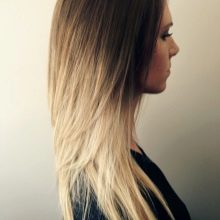
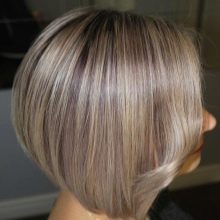

The most spectacular looks like coloring on a bob haircut. Moreover, the hair does not have to be very short, you can grow it up to the shoulders, and even a little lower. The highlight of this dyeing is that each lock is clearly visible due to the same length of hair on all sides.

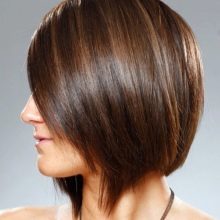
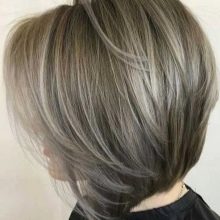
Below is a video tutorial on the implementation of the veil highlighting technique.
